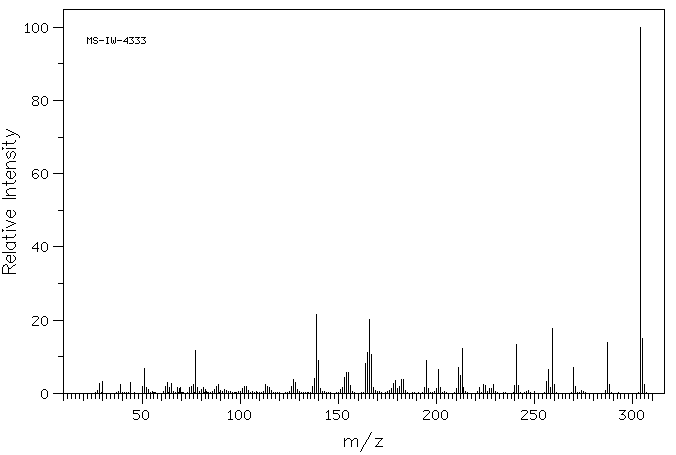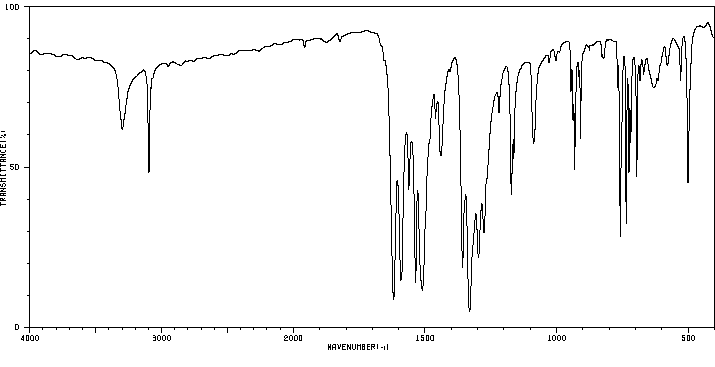2,4,6-三硝基二苯基胺 | 2919-12-2
中文名称
2,4,6-三硝基二苯基胺
中文别名
——
英文名称
trinitro-2,4,6 diphenylamine
英文别名
2,4,6-Trinitro-N-phenylaniline
CAS
2919-12-2
化学式
C12H8N4O6
mdl
MFCD00024418
分子量
304.219
InChiKey
GHWYJRRNNWVCPM-UHFFFAOYSA-N
BEILSTEIN
——
EINECS
——
-
物化性质
-
计算性质
-
ADMET
-
安全信息
-
SDS
-
制备方法与用途
-
上下游信息
-
文献信息
-
表征谱图
-
同类化合物
-
相关功能分类
-
相关结构分类
物化性质
-
沸点:445.06°C (rough estimate)
-
密度:1.4549 (rough estimate)
计算性质
-
辛醇/水分配系数(LogP):3.5
-
重原子数:22
-
可旋转键数:2
-
环数:2.0
-
sp3杂化的碳原子比例:0.0
-
拓扑面积:150
-
氢给体数:1
-
氢受体数:7
SDS
上下游信息
-
上游原料
中文名称 英文名称 CAS号 化学式 分子量 1,2,3,5-四硝基苯 1,2,3,5-tetranitrobenzene 3698-53-1 C6H2N4O8 258.104 N-甲基-2,4,6-三硝基苯胺 N-methylpicramide 1022-07-7 C7H6N4O6 242.148 N,N-二甲基-2,4,6-三硝基苯胺 N,N-dimethyl-2,4,6-trinitro-aniline 2493-31-4 C8H8N4O6 256.175 2-叠氮基-1,3,5-三硝基苯 2-azido-1,3,5-trinitro-benzene 1600-31-3 C6H2N6O6 254.118 (E)-二(2,4,6-三硝基苯基)二氮烯 2.2'.4.4'.6.6'-Hexanitroazobenzol 19159-68-3 C12H4N8O12 452.21 -
下游产品
中文名称 英文名称 CAS号 化学式 分子量 2,4,6-三硝基-N-(4-硝基苯基)苯胺 N-(p-nitrophenyl)picrylamine 38417-97-9 C12H7N5O8 349.216 N-(2,4-二硝基苯基)-2,4,6-三硝基苯胺 (2,4-dinitro-phenyl)-picryl-amine 21565-22-0 C12H6N6O10 394.214 氯苯那敏 Dipikrylamin 131-73-7 C12H5N7O12 439.211 2,4,6-三硝基-N-(2-硝基苯基)苯胺 2,4,6,2'-tetranitrodiphenylamine 38229-29-7 C12H7N5O8 349.216 N-甲基-2,4,6-三硝基-N-苯基苯胺 N-methyl-2,4,6-trinitrodiphenylamine 56042-31-0 C13H10N4O6 318.246
反应信息
-
作为反应物:描述:参考文献:名称:Flippen-Anderson, Judith L.; Gilardi, Richard D.; Pitt, Adrian M., Australian Journal of Chemistry, 1992, vol. 45, # 3, p. 513 - 524摘要:DOI:
-
作为产物:描述:alkaline earth salt of/the/ methylsulfuric acid 在 盐酸 作用下, 生成 2,4,6-三硝基二苯基胺参考文献:名称:Dziewonski; Russocki, Bulletin International de l'Academie Polonaise des Sciences et des Lettres, Classe des Sciences Mathematiques et Naturelles, Serie A: Sciences Mathematiques, 1929, p. 506,525摘要:DOI:
文献信息
-
Aromatic nucleophilic substitution reactions of 1-dialkylamino-substituted activated benzenes with various amines in dimethyl sulfoxide作者:Shizen Sekiguchi、Hiromi Ishikura、Yukitoshi Hirosawa、Nobuyuki OnoDOI:10.1016/s0040-4020(01)87755-3日期:1990.1In the reactions of 1-d1a1kylamino-2,4,6-trinitro- and 1-dialkylam1no-2, 4-dinitrobenzenes with various amines in dimethyl sulfoxide, 1-dialkylamino group is easily replaced with primary n-alkylamines at room temperature, and in a low yield with pyrrolidine only among secondary amines.
-
Steric and electronic effects on the mechanism of nucleophilic substitution (SNAr) reactions of some phenyl 2,4,6-trinitrophenyl ethers with aniline and N-methylaniline in acetonitrile and in dimethyl sulfoxide作者:Chukwuemeka Isanbor、Thomas A. Emokpae、Michael R. CramptonDOI:10.1039/b207997f日期:2002.12.6Rate data are reported for the reactions of a series of 3′- and 4′-substituted phenyl 2,4,6-trinitrophenyl ethers, 4, with aniline in acetonitrile, leading to 2,4,6-trinitrodiphenylamine. The main reaction flux occurs through a base catalysed pathway involving formation of a zwitterionic intermediate, equilibrium constant K1, and rate-limiting proton transfer to base, rate constant kAn. The effects of ring substituents on values of rate and equilibrium constants are discussed. In contrast the corresponding reactions in DMSO involve both uncatalysed and base catalysed pathways. Reactions of 4 with N-methylaniline are extremely slow, but values of rate constants for reaction of 4-nitrophenyl 2,4,6-trinitrophenyl ether were measured using 1H NMR spectroscopy. The value of the parameter K1kAn is lowered by a factor of 105 for N-methylaniline relative to aniline in both acetonitrile and in DMSO. This reduction is attributed to increased steric hindrance both in formation of the intermediate and to proton transfer.速率数据针对一系列3′-和4′-取代苯基2,4,6-三硝基苯基醚4与苯胺在丙酮腈中的反应进行了报告,该反应生成2,4,6-三硝基二苯胺。主要反应通路经由酸催化途径,涉及形成内盐中间体、平衡常数K1以及限制速率的质子转移至碱基,速率常数kAn。讨论了环取代基对速率和平衡常数值的影响。相比之下,在二甲基亚砜中对应的反应涉及未催化与酸催化两条途径。4与N-甲基苯胺的反应极其缓慢,但使用1H核磁共振光谱测量了4-硝基苯基2,4,6-三硝基苯基醚反应的速率常数值。在丙酮腈和二甲基亚砜中,对于N-甲基苯胺相较于苯胺,参数K1kAn的值降低了10的5次方倍。这种降低归因于在中间体形成与质子转移过程中的空间位阻增加。
-
The kinetics of the reaction of phenyl 2,4,6-trinitrophenyl ether with aniline in methanol, acetonitrile, tetrahydrofuran, ethyl acetate, and benzene作者:Olayinka Banjoko、Paul OtionoDOI:10.1039/p29810000399日期:——The kinetics of the reaction of phenyl 2,4,6-trinitrophenyl ether with aniline have been investigated as a function of the amine concentration in methanol, acetonitrile, tetrahydrofuran, ethyl acetate, and benzene. Base catalysis was observed in all the solvents. The second-order rate constant kA shows a linear correlation with the aniline concentration except in benzene where the linearity is with
-
Anilinolysis of Picryl Benzoate Derivatives in Methanol: Reactivity, Regioselectivity, Kinetics, and Mechanism作者:Mahmoud F. Ibrahim、Mohamed A. El-Atawy、Samir K. El-Sadany、Ezzat A. HamedDOI:10.1002/kin.20779日期:2013.9The reaction of picryl benzoate derivatives 1a–g with aniline in methanol proceeds through COO and ArO bond cleavage pathways. Furthermore, the reactivity of these esters toward anilinolysis is correlated to the energy gap between highest occupied molecular orbital aniline and lowest unoccupied molecular orbital of each ester. The regioselectivity of acyloxygen versus aryloxygen cleavage is also
-
The Synthesis of Vinylogous Amidine Heterocycles作者:Daniel V. LaBarbera、Edward B. SkiboDOI:10.1021/jo401927n日期:2013.12.6We report herein a convenient synthetic methodology for the conversion of meta-dinitro heterocyclic rings to iminoquinones with vinylogous amidine functionality. These structures are found in nature, particularly in marine organisms, and may be important for the pigments and biological activity observed with such marine secondary metabolites. Using benzimidazole and indole ring systems we show the
表征谱图
-
氢谱1HNMR
-
质谱MS
-
碳谱13CNMR
-
红外IR
-
拉曼Raman
-
峰位数据
-
峰位匹配
-
表征信息
同类化合物
(βS)-β-氨基-4-(4-羟基苯氧基)-3,5-二碘苯甲丙醇
(S,S)-邻甲苯基-DIPAMP
(S)-(-)-7'-〔4(S)-(苄基)恶唑-2-基]-7-二(3,5-二-叔丁基苯基)膦基-2,2',3,3'-四氢-1,1-螺二氢茚
(S)-盐酸沙丁胺醇
(S)-3-(叔丁基)-4-(2,6-二甲氧基苯基)-2,3-二氢苯并[d][1,3]氧磷杂环戊二烯
(S)-2,2'-双[双(3,5-三氟甲基苯基)膦基]-4,4',6,6'-四甲氧基联苯
(S)-1-[3,5-双(三氟甲基)苯基]-3-[1-(二甲基氨基)-3-甲基丁烷-2-基]硫脲
(R)富马酸托特罗定
(R)-(-)-盐酸尼古地平
(R)-(-)-4,12-双(二苯基膦基)[2.2]对环芳烷(1,5环辛二烯)铑(I)四氟硼酸盐
(R)-(+)-7-双(3,5-二叔丁基苯基)膦基7''-[((6-甲基吡啶-2-基甲基)氨基]-2,2'',3,3''-四氢-1,1''-螺双茚满
(R)-(+)-7-双(3,5-二叔丁基苯基)膦基7''-[(4-叔丁基吡啶-2-基甲基)氨基]-2,2'',3,3''-四氢-1,1''-螺双茚满
(R)-(+)-7-双(3,5-二叔丁基苯基)膦基7''-[(3-甲基吡啶-2-基甲基)氨基]-2,2'',3,3''-四氢-1,1''-螺双茚满
(R)-(+)-4,7-双(3,5-二-叔丁基苯基)膦基-7“-[(吡啶-2-基甲基)氨基]-2,2”,3,3'-四氢1,1'-螺二茚满
(R)-3-(叔丁基)-4-(2,6-二苯氧基苯基)-2,3-二氢苯并[d][1,3]氧杂磷杂环戊烯
(R)-2-[((二苯基膦基)甲基]吡咯烷
(R)-1-[3,5-双(三氟甲基)苯基]-3-[1-(二甲基氨基)-3-甲基丁烷-2-基]硫脲
(N-(4-甲氧基苯基)-N-甲基-3-(1-哌啶基)丙-2-烯酰胺)
(5-溴-2-羟基苯基)-4-氯苯甲酮
(5-溴-2-氯苯基)(4-羟基苯基)甲酮
(5-氧代-3-苯基-2,5-二氢-1,2,3,4-oxatriazol-3-鎓)
(4S,5R)-4-甲基-5-苯基-1,2,3-氧代噻唑烷-2,2-二氧化物-3-羧酸叔丁酯
(4S,4''S)-2,2''-亚环戊基双[4,5-二氢-4-(苯甲基)恶唑]
(4-溴苯基)-[2-氟-4-[6-[甲基(丙-2-烯基)氨基]己氧基]苯基]甲酮
(4-丁氧基苯甲基)三苯基溴化磷
(3aR,8aR)-(-)-4,4,8,8-四(3,5-二甲基苯基)四氢-2,2-二甲基-6-苯基-1,3-二氧戊环[4,5-e]二恶唑磷
(3aR,6aS)-5-氧代六氢环戊基[c]吡咯-2(1H)-羧酸酯
(2Z)-3-[[(4-氯苯基)氨基]-2-氰基丙烯酸乙酯
(2S,3S,5S)-5-(叔丁氧基甲酰氨基)-2-(N-5-噻唑基-甲氧羰基)氨基-1,6-二苯基-3-羟基己烷
(2S,2''S,3S,3''S)-3,3''-二叔丁基-4,4''-双(2,6-二甲氧基苯基)-2,2'',3,3''-四氢-2,2''-联苯并[d][1,3]氧杂磷杂戊环
(2S)-(-)-2-{[[[[3,5-双(氟代甲基)苯基]氨基]硫代甲基]氨基}-N-(二苯基甲基)-N,3,3-三甲基丁酰胺
(2S)-2-[[[[[((1S,2S)-2-氨基环己基]氨基]硫代甲基]氨基]-N-(二苯甲基)-N,3,3-三甲基丁酰胺
(2S)-2-[[[[[[((1R,2R)-2-氨基环己基]氨基]硫代甲基]氨基]-N-(二苯甲基)-N,3,3-三甲基丁酰胺
(2-硝基苯基)磷酸三酰胺
(2,6-二氯苯基)乙酰氯
(2,3-二甲氧基-5-甲基苯基)硼酸
(1S,2S,3S,5S)-5-叠氮基-3-(苯基甲氧基)-2-[(苯基甲氧基)甲基]环戊醇
(1S,2S,3R,5R)-2-(苄氧基)甲基-6-氧杂双环[3.1.0]己-3-醇
(1-(4-氟苯基)环丙基)甲胺盐酸盐
(1-(3-溴苯基)环丁基)甲胺盐酸盐
(1-(2-氯苯基)环丁基)甲胺盐酸盐
(1-(2-氟苯基)环丙基)甲胺盐酸盐
(1-(2,6-二氟苯基)环丙基)甲胺盐酸盐
(-)-去甲基西布曲明
龙蒿油
龙胆酸钠
龙胆酸叔丁酯
龙胆酸
龙胆紫-d6
龙胆紫








